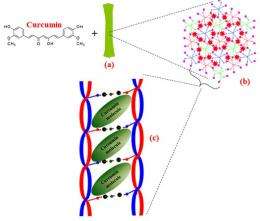Pass the lycopene: Scientist can protect supplements inside food

(PhysOrg.com) -- A Purdue University food scientist has developed a way to encase nutritional supplements in food-based products so that one day consumers might be able to sprinkle vitamins, antioxidants and other beneficial compounds right onto their meals.
Srinivas Janaswamy, a research assistant professor of food science, said many of the nutraceuticals, or nutritional supplements, added to foods today are not structurally stable. Heat, light, oxygen and other external factors could degrade the supplements, rendering them ineffective.
"There are many methods for adding nutraceuticals to foods, but the one thing they all have in common is instability due to non-rigid structures," said Janaswamy, whose findings were published in the journal Food & Function.
Nutraceuticals such as beta-carotene, lycopene, resveratrol and vitamins are thought to play significant roles in treating or preventing disease. Resveratrol, for example, is found in red grape products and is believed to help prevent cancer and benefit cardiovascular health.
Janaswamy's method involves creating crystalline-like fibers that embed the nutraceuticals, protect them from external influences and prevent degradation.
"Once the nutraceutical is enveloped, it is thermally protected," Janaswamy said. "Anything of interest can be used, even drug molecules, vitamins or hormones."
Janaswamy used iota-carrageenan, a long-chain carbohydrate, to encapsulate curcumin, the principle compound found in the spice turmeric, which is considered to be effective against inflammation, cancer and obesity. Iota-carrageenan is amorphous, meaning it lacks a defined structural arrangement. It was stretched, forming well-oriented crystalline fibers, which then gained more structural organization.
In the fiber network, iota-carrageenan maintains a stable double-helical structure with small pockets between the helices that contain water molecules. Janaswamy replaced these water pockets with curcumin, which was then protected by the sturdy iota-carrageenan network.
Janaswamy envisions that the encapsulated fibers could then be chopped into small particles. Diners could reach for the resveratrol or curcumin the same as they might salt or pepper.
Iota-carrageenan and other polysaccharide carbohydrates have GRAS – generally recognized as safe - status with the U.S. Department of Agriculture.
Janaswamy has a few hurdles to overcome before his nutraceutical fibers are ready for dinner tables. He is working on delaying the release of the embedded compounds once consumed, as their current release time is about 30 minutes. Janaswamy said the time would need to be lengthened to about three hours to ensure that the nutraceuticals reach the intestines, where they can be properly absorbed. Also, Janaswamy is working to increase the amount of nutraceutical that can be loaded into the fibers.
Susanne R. Youngren, a former Purdue undergraduate student and current doctoral student at the University of Hawaii at Hilo, collaborated with Janaswamy on this research. Purdue's Whistler Center for Carbohydrate Research provided funding.
More information: Hydrocolloid-based Nutraceutical Delivery Systems, Srinivas Janaswamy and Susanne R. Youngren, Food & Function.
ABSTRACT
Nutraceuticals are important due to their inherent health benefits. However, utilization and consumption are limited by their poor water solubility and instability at normal processing and storage conditions. Herein, we propose an elegant and novel approach for the delivery of nutraceuticals in their active form using hydrocolloid matrices that are inexpensive and non-toxic with generally recognized as safe (GRAS) status. Iota-carrageenan and curcumin have been chosen as models of hydrocolloid and nutraceutical compounds, respectively. The iota-carrageenan network maintains a stable organization after encapsulating curcumin molecules, protects them from melting and then releases them in a sustained manner. These findings lay a strong foundation for developing value-added functional and medicinal foods.
Provided by Purdue University
















